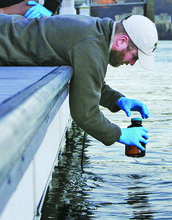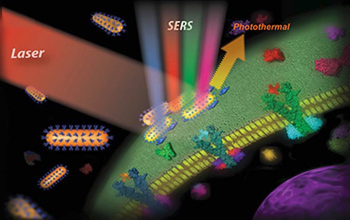All Images
News Release 15-080
NSF invests in science and engineering infrastructure across the nation
Arkansas, Louisiana, West Virginia, and Guam will receive five-year awards for strategically aligned innovative research
This material is available primarily for archival purposes. Telephone numbers or other contact information may be out of date; please see current contact information at media contacts.

Students in front of a high-temperature high-vacuum molding system used for replication of metal-based microscale structures. Appearing from left to right: Everest Ejigiri (Southern University) and Bin Zhang (Louisiana State University).
Credit: Eddy Perez, LSU University Relations
Download the high-resolution JPG version of the image. (1.7 MB)
Use your mouse to right-click (Mac users may need to Ctrl-click) the link above and choose the option that will save the file or target to your computer.

A student collects a water sample following a chemical spill that contaminated the water supply for thousands of West Virginians in January 2014. An interdisciplinary team of researchers quickly sought and received a National Science Foundation RAPID grant to analyze samples.
Credit: West Virginia Higher Education Policy Commission
Download the high-resolution JPG version of the image. (1.1 MB)
Use your mouse to right-click (Mac users may need to Ctrl-click) the link above and choose the option that will save the file or target to your computer.

Nanostructural materials with tunable architectures and morphologies present unique electrical, optical, magnetic or mechanical properties. Such nanomaterials will be synthesized and their complex interactions with various biological systems will be tested to fully understand how their morphology controls their characteristics and ability to be used as highly sensitive agents to control biological processes. Such multifunctional materials will have applications in the areas of advanced materials, nanomedicine, sensing, or biology. Plasmonically active nanostructures with strong spectroscopic signatures can be used for biomedical applications.
Credit: Zeid Nima, Center for Integrative Nanotechnology Sciences, University of Arkansas at Little Rock
Download the high-resolution JPG version of the image. (72.8 KB)
Use your mouse to right-click (Mac users may need to Ctrl-click) the link above and choose the option that will save the file or target to your computer.


